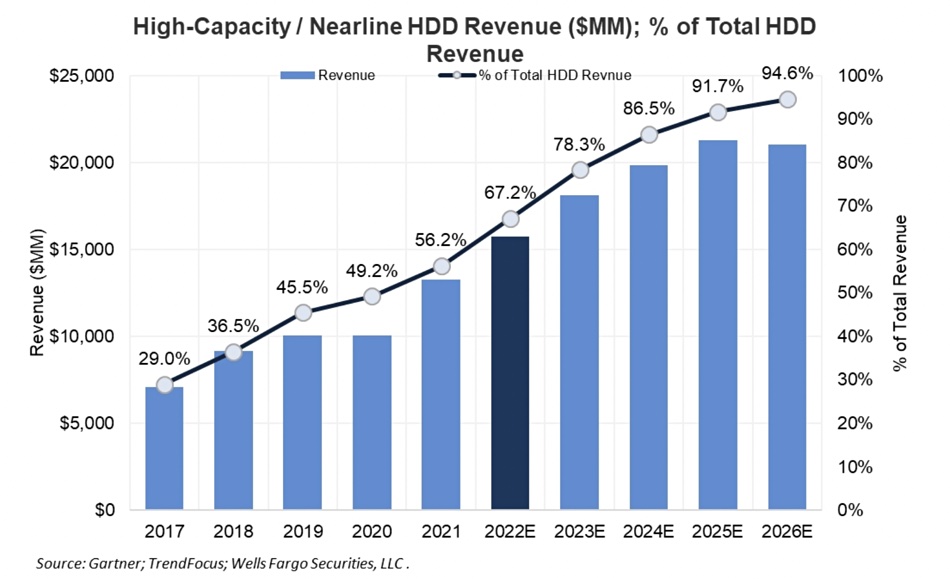In today’s information hungry age, there are more data center hard drives in deployment than ever before. But, what happens when your enterprise HDD reach the end of their useful life—simply cut your losses, replace, and move on?
Not so fast. Here are five steps you can take to maximize your return on retiring hard drives.
Step #1 – Know Your HDD’s Value
Hard disk drives hold more value than you might realize. As the dominant storage technology in the enterprise data center, the market outlook for data center hard drives is strong.
- Fueled by the uptick in data generation across all aspects of daily life, demand for nearline storage capacity keeps growing year-on-year, avoiding the dip in shipped units for other HDD categories.
- Hard drive capacities are up. The major manufacturers are touting 22TB devices while teasing product road maps that run significantly higher, driving up ASPs for enterprise HDD.
- SSD may gradually take a larger slice of the pie, but the pie itself is growing, and nearline HDD revenue is likely to do so for years to come.

So, the next time you check your IT asset management system for the latest drive count, remind yourself of the value locked in these devices.
Refurbished SATA vs SAS
While the performance benefits of new SAS drives make them moderately more expensive than their SATA counterparts, SATA drives tend to better hold their value refurbished. A greater appetite for deploying refurbished SATA drives in the data center makes for a more robust secondary market. Get in touch with Horizon Technology for more information about refurbished SAS and SATA drives.
Step #2 – Plan for Decommissioning
To fully maximize value recovery from HDD, don’t wait until it’s time to retire the asset.
Instead, establish a decommissioning plan at the time of the drive’s deployment, organized around your refresh cycles. Steps include:
- Entering the device into your configuration management database (CMDB) and IT asset management (ITAM) software. Visibility is key to effective hardware lifecycle management.
- Determining at the outset whether to internally redeploy or securely remarket the device upon its decommission.
- Deciding the best approach to data sanitization, dependent on the drive’s specifications and the nature of the data earmarked for the media.
Again, work with your ITAD expert to devise a lifecycle plan for each device as it enters deployment.
Step #3 – Monitor Drive Performance
Once your devices are in operation, closely tracking their performance will yield insights that maximize value recovery down the line.
As with any equipment you own, the better you understand your data center hard drives, the more confidently you will cultivate return when it’s time to dispose of the assets.
With this in mind:
- Use S.M.A.R.T. testing data (from usage and power-on hours to temperature and sector remapping) to regularly monitor for exceptions in RAID and non-RAID environments.
- Review the performance data for each drive group. Analyze according to serial number and date of deployment.
- Establish internal protocols for failed drives. Collate data and identify any discernible patterns, such as those associated with the drive’s burn-in period.
Good news: increased chance of failure during the burn-in period isn’t inevitable. In 2021, Backblaze examined data collected in the six previous years and found little evidence of high failure rates during the burn-in period.
When ascertaining your drive’s reliability, don’t soldier on alone. For industry support, compare your performance stats against cloud storage leader Backblaze’s benchmark data, stretching back to 2013.
Managing Failed Drives
It’s important to establish a process for returning failed drives still under warranty. Lean on your ITAD partner for support liaising with the OEM when returning and replacing drives. (Depending on power-on hours and whether the device meets minimum QA standards, the failed drive may itself get recertified.) Your ITAD can also help you navigate stock-outs and other supply chain gaps.
Step #4 – Prioritize Data Sanitization
Nothing is more important in the asset disposition and value recovery process than drive sanitization.
The consequences of failing to sanitize data properly can be severe. Just look at the steady drip feed of data breaches where hard drives go missing or storage media are not comprehensively wiped.
Work with your ITAD provider to devise a robust workflow intended to eliminate these risks.
- Will the data erasure take place on-site or off-site?
- What overwriting pattern will you deploy for the drives?
- How secure is the chain of custody?
Request your ITAD partner issues comprehensive certificates of data destruction for sanitized media. As high-profile cases have demonstrated, data reporting and asset reconciliation are as important as the rigor of the data sanitization itself.
The greater confidence you have in the sanitization and surrounding process, the greater your willingness to entertain options for the secure remarketing of the drives.
Step #5 – Explore Secure Remarketing
There’s a growing industry appetite for secure reuse and remarketing of enterprise HDD. Remarketing is good for the environment and for the bottom line.
You’re in good company. Key industry players are collaborating to develop common standards for reuse intended to support the strengthening of secondary markets. Areas under review include:
- Promoting interoperability and specifying secure non-destructive means of purging data.
- Fostering collaboration and knowledge sharing through workshops, webinars, and conferences.
- Encouraging the inclusion of environmental requirements, such as product longevity, in purchase specifications.
As you approach a decommissioning or storage refresh, expect your IT asset disposition partner to supply you with clear guidance on secure remarketing. This will range from real-time market pricing for decommissioned hard drives to expert support with compliant data destruction.
Maximize Your Return
Don’t leave money on the table. By partnering with the right ITAD, one with deep expertise in data center storage, you stand to maximize the value recovery on your retiring drives.
Get in touch with the experts at Horizon Technology for support with all aspects of your data center drives.











